Financial Accounting 1: Financial Reporting and Accounting Principles
VerifiedAdded on 2023/01/10
|22
|4501
|43
Report
AI Summary
This financial accounting report delves into key concepts such as business transactions, encompassing sales, purchases, receipts, and payments, and their recording using single and double-entry bookkeeping methods. It explores the significance of the trial balance in verifying arithmetic accuracy and preparing financial statements. The report further distinguishes between financial reports and financial statements, outlining their differences in content, scope, and users. It also explains fundamental accounting principles, including monetary unit accounting, the going concern principle, and conservatism. The report examines journal entries, ledger accounts, and trial balance. Additionally, the report touches on bank reconciliation and control accounts, providing a complete analysis of financial accounting principles and practices.
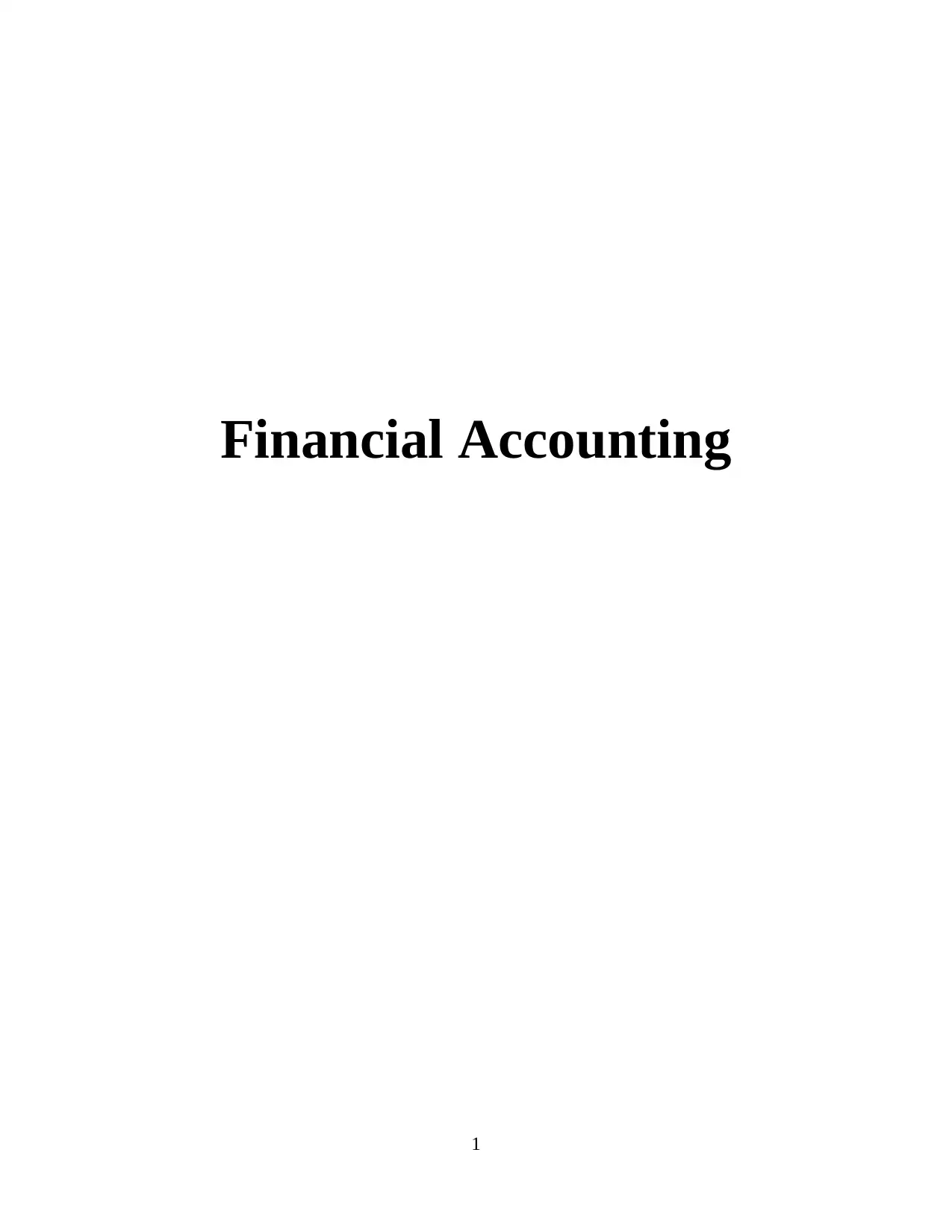
Financial Accounting
1
1
Paraphrase This Document
Need a fresh take? Get an instant paraphrase of this document with our AI Paraphraser
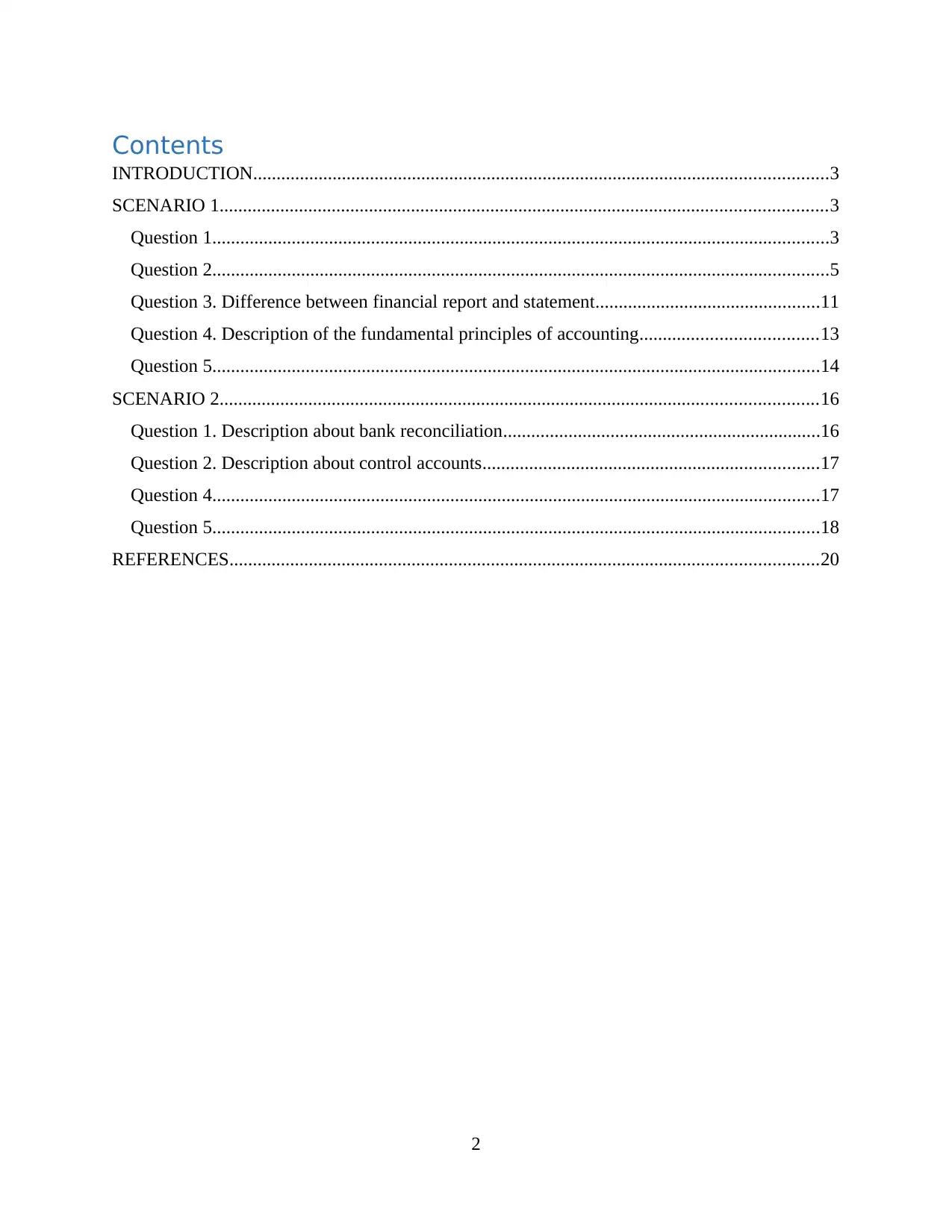
Contents
INTRODUCTION...........................................................................................................................3
SCENARIO 1..................................................................................................................................3
Question 1....................................................................................................................................3
Question 2....................................................................................................................................5
Question 3. Difference between financial report and statement................................................11
Question 4. Description of the fundamental principles of accounting......................................13
Question 5..................................................................................................................................14
SCENARIO 2................................................................................................................................16
Question 1. Description about bank reconciliation....................................................................16
Question 2. Description about control accounts........................................................................17
Question 4..................................................................................................................................17
Question 5..................................................................................................................................18
REFERENCES..............................................................................................................................20
2
INTRODUCTION...........................................................................................................................3
SCENARIO 1..................................................................................................................................3
Question 1....................................................................................................................................3
Question 2....................................................................................................................................5
Question 3. Difference between financial report and statement................................................11
Question 4. Description of the fundamental principles of accounting......................................13
Question 5..................................................................................................................................14
SCENARIO 2................................................................................................................................16
Question 1. Description about bank reconciliation....................................................................16
Question 2. Description about control accounts........................................................................17
Question 4..................................................................................................................................17
Question 5..................................................................................................................................18
REFERENCES..............................................................................................................................20
2
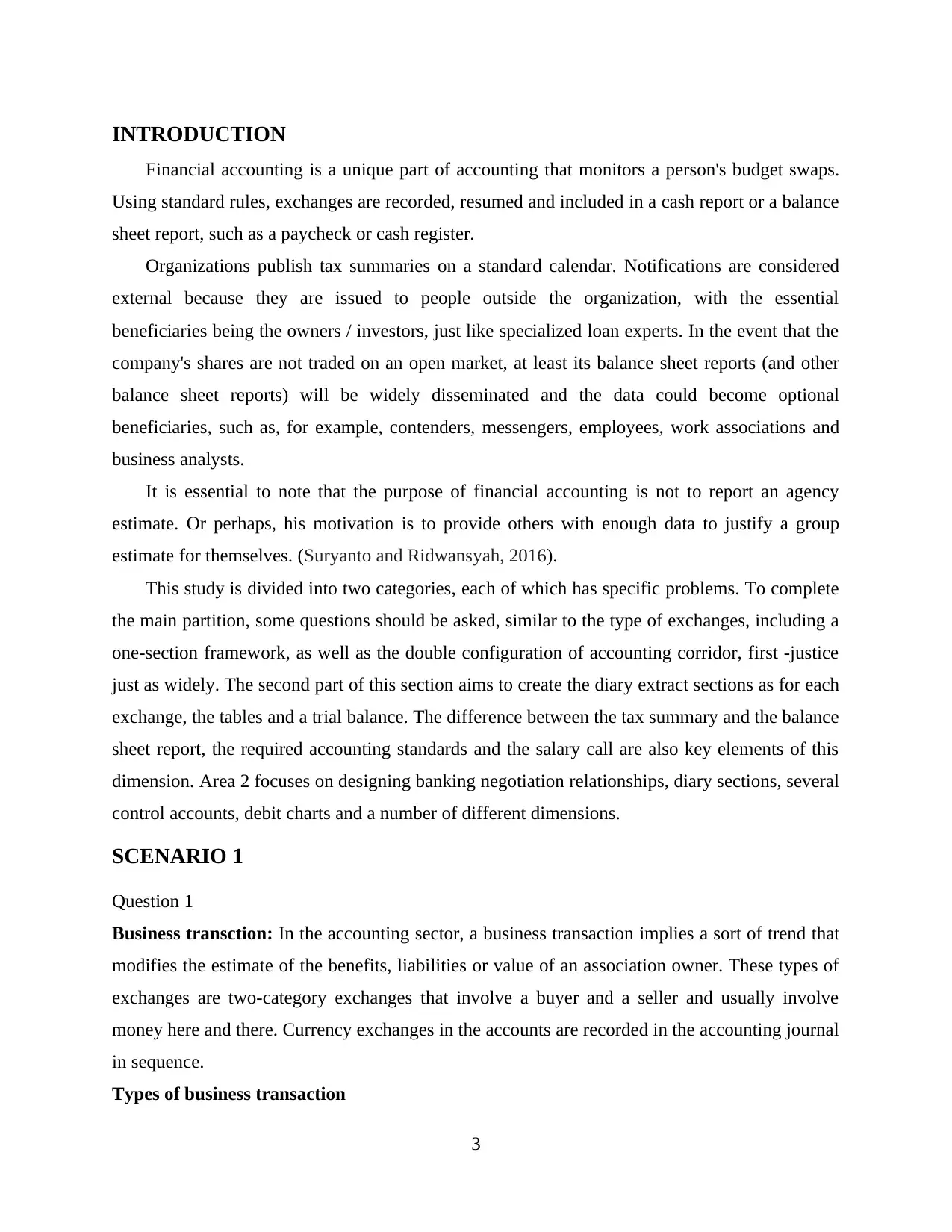
INTRODUCTION
Financial accounting is a unique part of accounting that monitors a person's budget swaps.
Using standard rules, exchanges are recorded, resumed and included in a cash report or a balance
sheet report, such as a paycheck or cash register.
Organizations publish tax summaries on a standard calendar. Notifications are considered
external because they are issued to people outside the organization, with the essential
beneficiaries being the owners / investors, just like specialized loan experts. In the event that the
company's shares are not traded on an open market, at least its balance sheet reports (and other
balance sheet reports) will be widely disseminated and the data could become optional
beneficiaries, such as, for example, contenders, messengers, employees, work associations and
business analysts.
It is essential to note that the purpose of financial accounting is not to report an agency
estimate. Or perhaps, his motivation is to provide others with enough data to justify a group
estimate for themselves. (Suryanto and Ridwansyah, 2016).
This study is divided into two categories, each of which has specific problems. To complete
the main partition, some questions should be asked, similar to the type of exchanges, including a
one-section framework, as well as the double configuration of accounting corridor, first -justice
just as widely. The second part of this section aims to create the diary extract sections as for each
exchange, the tables and a trial balance. The difference between the tax summary and the balance
sheet report, the required accounting standards and the salary call are also key elements of this
dimension. Area 2 focuses on designing banking negotiation relationships, diary sections, several
control accounts, debit charts and a number of different dimensions.
SCENARIO 1
Question 1
Business transction: In the accounting sector, a business transaction implies a sort of trend that
modifies the estimate of the benefits, liabilities or value of an association owner. These types of
exchanges are two-category exchanges that involve a buyer and a seller and usually involve
money here and there. Currency exchanges in the accounts are recorded in the accounting journal
in sequence.
Types of business transaction
3
Financial accounting is a unique part of accounting that monitors a person's budget swaps.
Using standard rules, exchanges are recorded, resumed and included in a cash report or a balance
sheet report, such as a paycheck or cash register.
Organizations publish tax summaries on a standard calendar. Notifications are considered
external because they are issued to people outside the organization, with the essential
beneficiaries being the owners / investors, just like specialized loan experts. In the event that the
company's shares are not traded on an open market, at least its balance sheet reports (and other
balance sheet reports) will be widely disseminated and the data could become optional
beneficiaries, such as, for example, contenders, messengers, employees, work associations and
business analysts.
It is essential to note that the purpose of financial accounting is not to report an agency
estimate. Or perhaps, his motivation is to provide others with enough data to justify a group
estimate for themselves. (Suryanto and Ridwansyah, 2016).
This study is divided into two categories, each of which has specific problems. To complete
the main partition, some questions should be asked, similar to the type of exchanges, including a
one-section framework, as well as the double configuration of accounting corridor, first -justice
just as widely. The second part of this section aims to create the diary extract sections as for each
exchange, the tables and a trial balance. The difference between the tax summary and the balance
sheet report, the required accounting standards and the salary call are also key elements of this
dimension. Area 2 focuses on designing banking negotiation relationships, diary sections, several
control accounts, debit charts and a number of different dimensions.
SCENARIO 1
Question 1
Business transction: In the accounting sector, a business transaction implies a sort of trend that
modifies the estimate of the benefits, liabilities or value of an association owner. These types of
exchanges are two-category exchanges that involve a buyer and a seller and usually involve
money here and there. Currency exchanges in the accounts are recorded in the accounting journal
in sequence.
Types of business transaction
3
⊘ This is a preview!⊘
Do you want full access?
Subscribe today to unlock all pages.

Trusted by 1+ million students worldwide
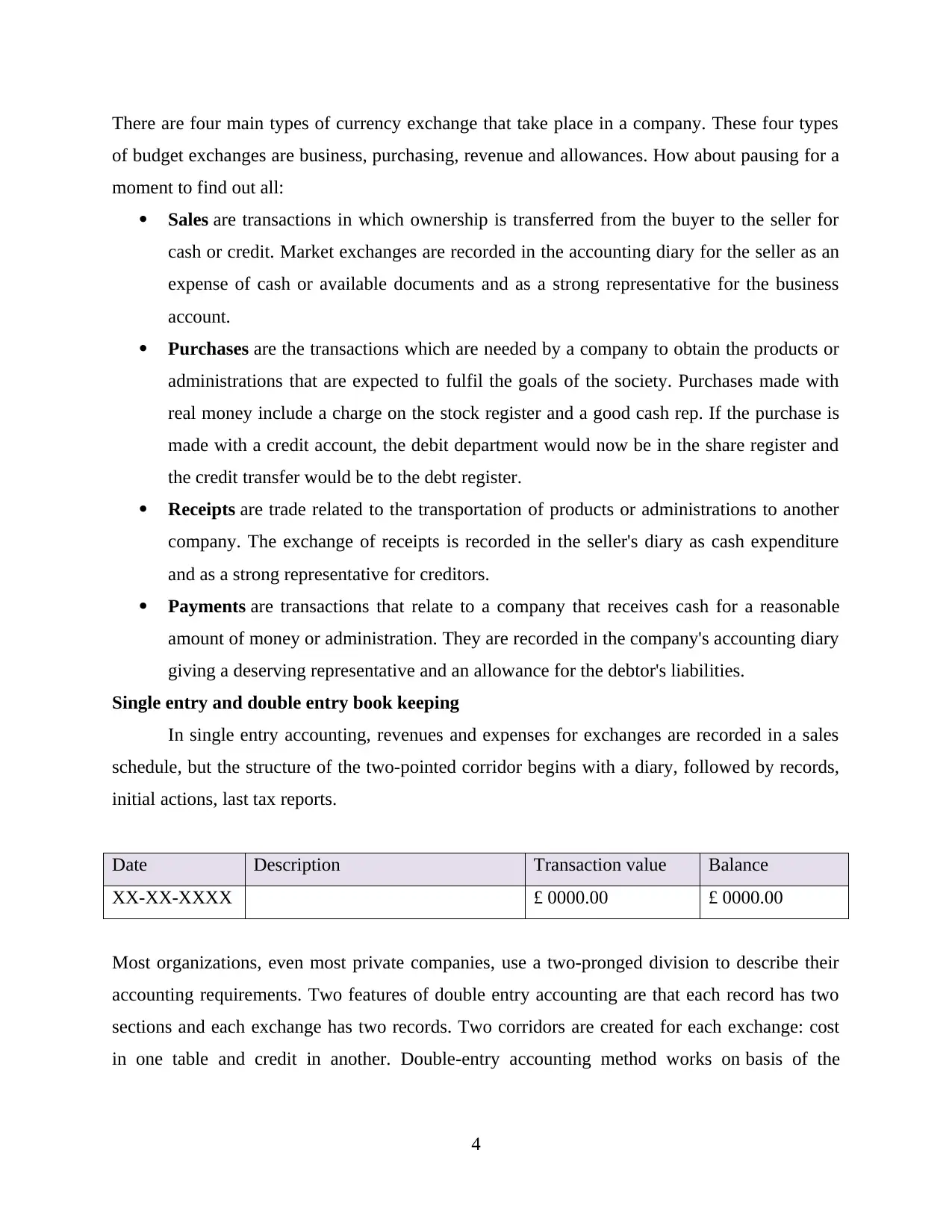
There are four main types of currency exchange that take place in a company. These four types
of budget exchanges are business, purchasing, revenue and allowances. How about pausing for a
moment to find out all:
Sales are transactions in which ownership is transferred from the buyer to the seller for
cash or credit. Market exchanges are recorded in the accounting diary for the seller as an
expense of cash or available documents and as a strong representative for the business
account.
Purchases are the transactions which are needed by a company to obtain the products or
administrations that are expected to fulfil the goals of the society. Purchases made with
real money include a charge on the stock register and a good cash rep. If the purchase is
made with a credit account, the debit department would now be in the share register and
the credit transfer would be to the debt register.
Receipts are trade related to the transportation of products or administrations to another
company. The exchange of receipts is recorded in the seller's diary as cash expenditure
and as a strong representative for creditors.
Payments are transactions that relate to a company that receives cash for a reasonable
amount of money or administration. They are recorded in the company's accounting diary
giving a deserving representative and an allowance for the debtor's liabilities.
Single entry and double entry book keeping
In single entry accounting, revenues and expenses for exchanges are recorded in a sales
schedule, but the structure of the two-pointed corridor begins with a diary, followed by records,
initial actions, last tax reports.
Date Description Transaction value Balance
XX-XX-XXXX £ 0000.00 £ 0000.00
Most organizations, even most private companies, use a two-pronged division to describe their
accounting requirements. Two features of double entry accounting are that each record has two
sections and each exchange has two records. Two corridors are created for each exchange: cost
in one table and credit in another. Double-entry accounting method works on basis of the
4
of budget exchanges are business, purchasing, revenue and allowances. How about pausing for a
moment to find out all:
Sales are transactions in which ownership is transferred from the buyer to the seller for
cash or credit. Market exchanges are recorded in the accounting diary for the seller as an
expense of cash or available documents and as a strong representative for the business
account.
Purchases are the transactions which are needed by a company to obtain the products or
administrations that are expected to fulfil the goals of the society. Purchases made with
real money include a charge on the stock register and a good cash rep. If the purchase is
made with a credit account, the debit department would now be in the share register and
the credit transfer would be to the debt register.
Receipts are trade related to the transportation of products or administrations to another
company. The exchange of receipts is recorded in the seller's diary as cash expenditure
and as a strong representative for creditors.
Payments are transactions that relate to a company that receives cash for a reasonable
amount of money or administration. They are recorded in the company's accounting diary
giving a deserving representative and an allowance for the debtor's liabilities.
Single entry and double entry book keeping
In single entry accounting, revenues and expenses for exchanges are recorded in a sales
schedule, but the structure of the two-pointed corridor begins with a diary, followed by records,
initial actions, last tax reports.
Date Description Transaction value Balance
XX-XX-XXXX £ 0000.00 £ 0000.00
Most organizations, even most private companies, use a two-pronged division to describe their
accounting requirements. Two features of double entry accounting are that each record has two
sections and each exchange has two records. Two corridors are created for each exchange: cost
in one table and credit in another. Double-entry accounting method works on basis of the
4
Paraphrase This Document
Need a fresh take? Get an instant paraphrase of this document with our AI Paraphraser
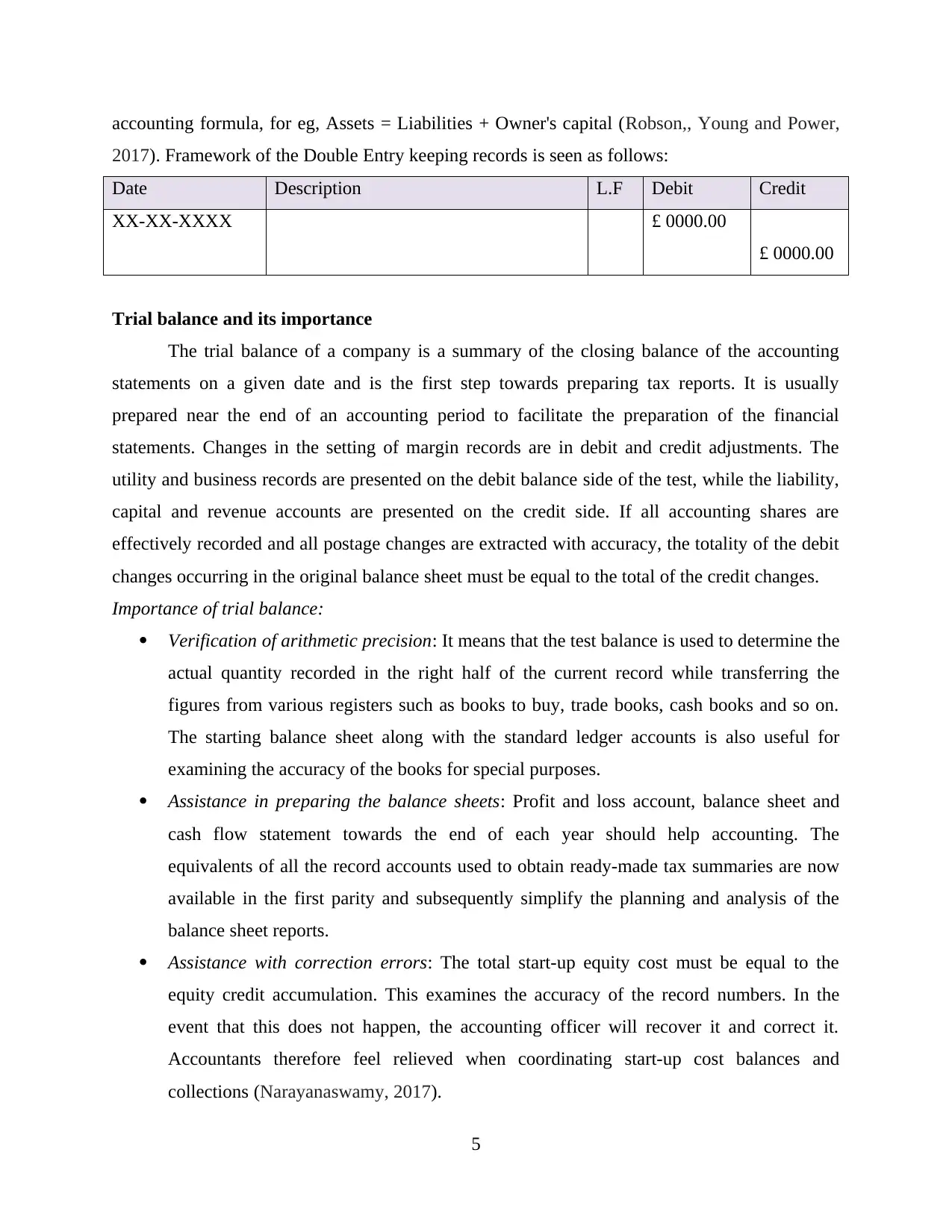
accounting formula, for eg, Assets = Liabilities + Owner's capital (Robson,, Young and Power,
2017). Framework of the Double Entry keeping records is seen as follows:
Date Description L.F Debit Credit
XX-XX-XXXX £ 0000.00
£ 0000.00
Trial balance and its importance
The trial balance of a company is a summary of the closing balance of the accounting
statements on a given date and is the first step towards preparing tax reports. It is usually
prepared near the end of an accounting period to facilitate the preparation of the financial
statements. Changes in the setting of margin records are in debit and credit adjustments. The
utility and business records are presented on the debit balance side of the test, while the liability,
capital and revenue accounts are presented on the credit side. If all accounting shares are
effectively recorded and all postage changes are extracted with accuracy, the totality of the debit
changes occurring in the original balance sheet must be equal to the total of the credit changes.
Importance of trial balance:
Verification of arithmetic precision: It means that the test balance is used to determine the
actual quantity recorded in the right half of the current record while transferring the
figures from various registers such as books to buy, trade books, cash books and so on.
The starting balance sheet along with the standard ledger accounts is also useful for
examining the accuracy of the books for special purposes.
Assistance in preparing the balance sheets: Profit and loss account, balance sheet and
cash flow statement towards the end of each year should help accounting. The
equivalents of all the record accounts used to obtain ready-made tax summaries are now
available in the first parity and subsequently simplify the planning and analysis of the
balance sheet reports.
Assistance with correction errors: The total start-up equity cost must be equal to the
equity credit accumulation. This examines the accuracy of the record numbers. In the
event that this does not happen, the accounting officer will recover it and correct it.
Accountants therefore feel relieved when coordinating start-up cost balances and
collections (Narayanaswamy, 2017).
5
2017). Framework of the Double Entry keeping records is seen as follows:
Date Description L.F Debit Credit
XX-XX-XXXX £ 0000.00
£ 0000.00
Trial balance and its importance
The trial balance of a company is a summary of the closing balance of the accounting
statements on a given date and is the first step towards preparing tax reports. It is usually
prepared near the end of an accounting period to facilitate the preparation of the financial
statements. Changes in the setting of margin records are in debit and credit adjustments. The
utility and business records are presented on the debit balance side of the test, while the liability,
capital and revenue accounts are presented on the credit side. If all accounting shares are
effectively recorded and all postage changes are extracted with accuracy, the totality of the debit
changes occurring in the original balance sheet must be equal to the total of the credit changes.
Importance of trial balance:
Verification of arithmetic precision: It means that the test balance is used to determine the
actual quantity recorded in the right half of the current record while transferring the
figures from various registers such as books to buy, trade books, cash books and so on.
The starting balance sheet along with the standard ledger accounts is also useful for
examining the accuracy of the books for special purposes.
Assistance in preparing the balance sheets: Profit and loss account, balance sheet and
cash flow statement towards the end of each year should help accounting. The
equivalents of all the record accounts used to obtain ready-made tax summaries are now
available in the first parity and subsequently simplify the planning and analysis of the
balance sheet reports.
Assistance with correction errors: The total start-up equity cost must be equal to the
equity credit accumulation. This examines the accuracy of the record numbers. In the
event that this does not happen, the accounting officer will recover it and correct it.
Accountants therefore feel relieved when coordinating start-up cost balances and
collections (Narayanaswamy, 2017).
5
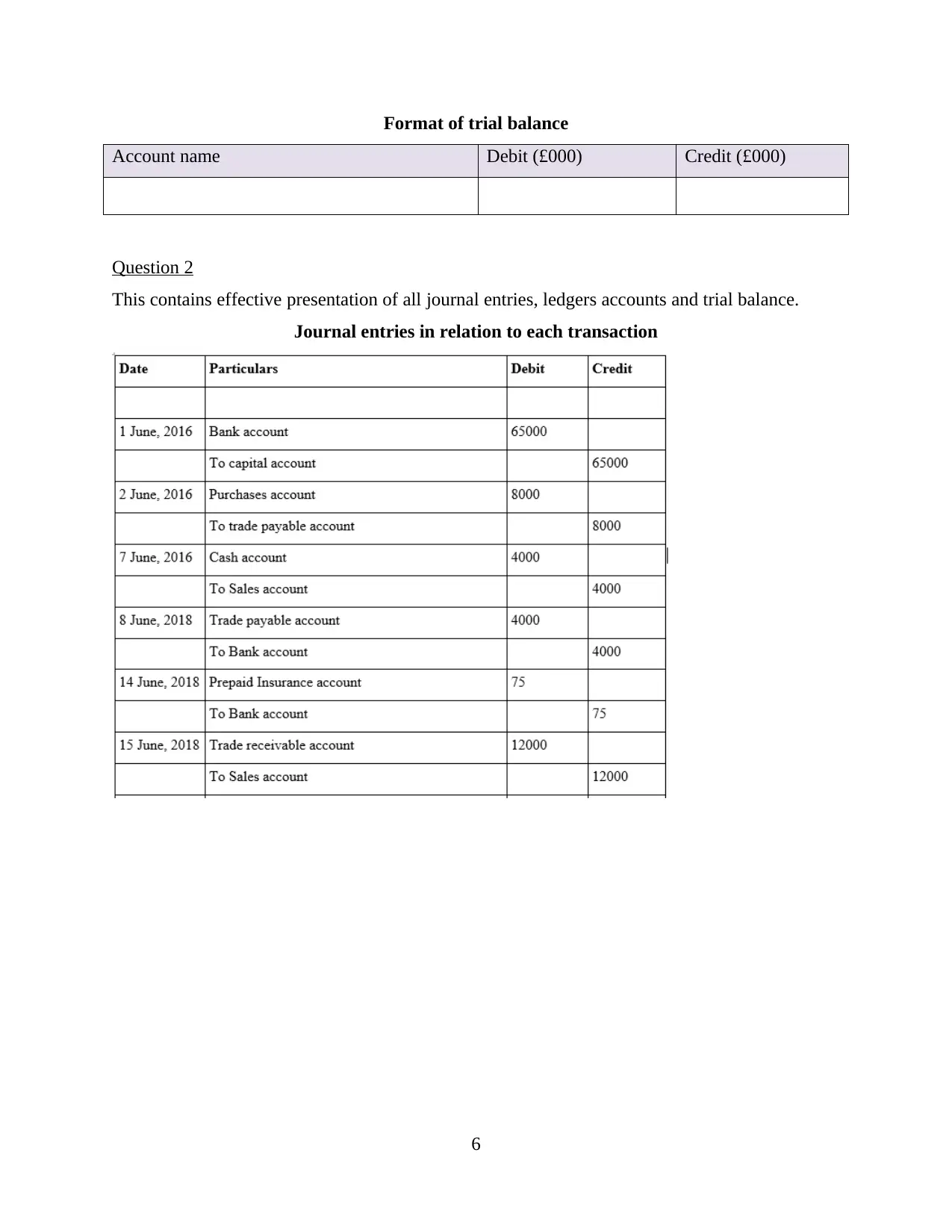
Format of trial balance
Account name Debit (£000) Credit (£000)
Question 2
This contains effective presentation of all journal entries, ledgers accounts and trial balance.
Journal entries in relation to each transaction
6
Account name Debit (£000) Credit (£000)
Question 2
This contains effective presentation of all journal entries, ledgers accounts and trial balance.
Journal entries in relation to each transaction
6
⊘ This is a preview!⊘
Do you want full access?
Subscribe today to unlock all pages.

Trusted by 1+ million students worldwide
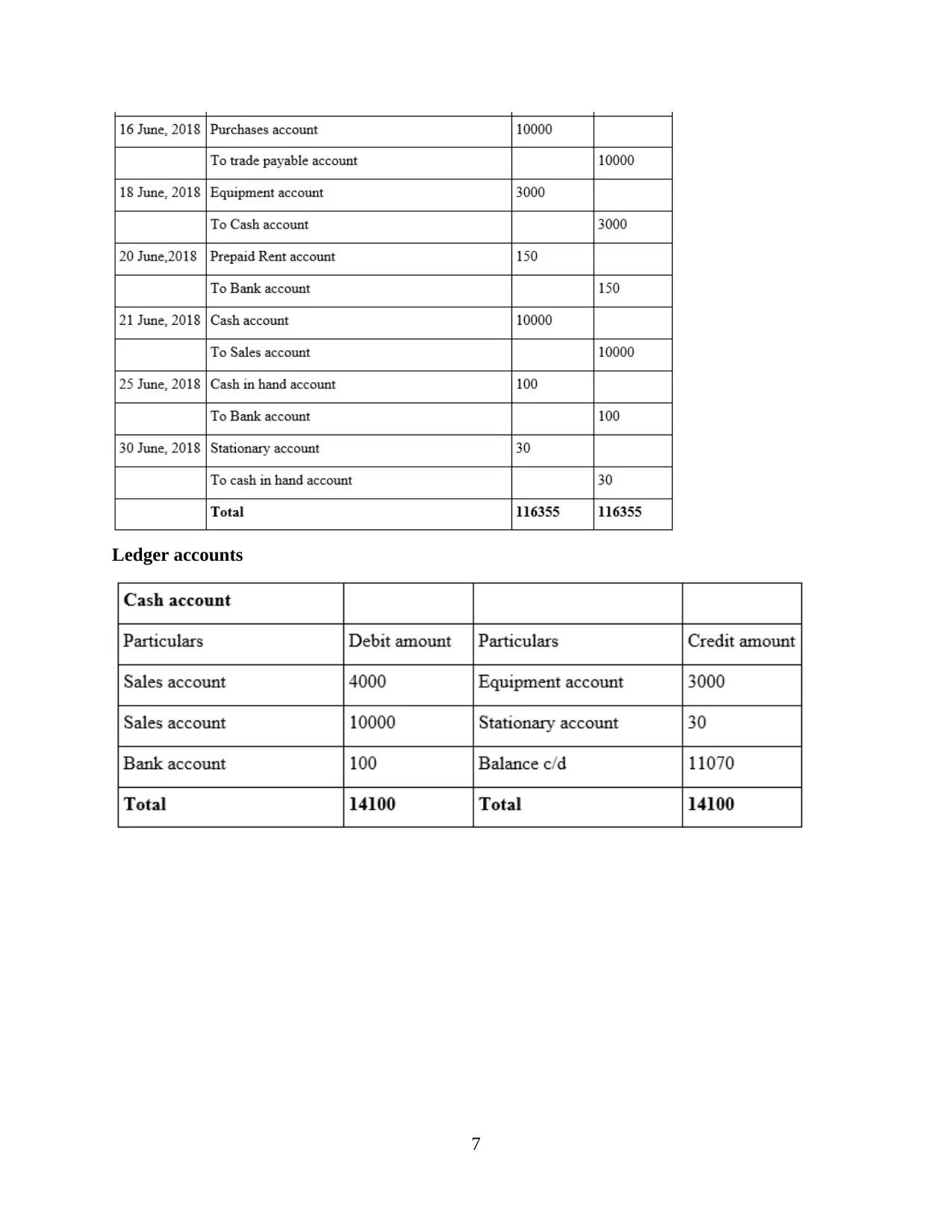
Ledger accounts
7
7
Paraphrase This Document
Need a fresh take? Get an instant paraphrase of this document with our AI Paraphraser
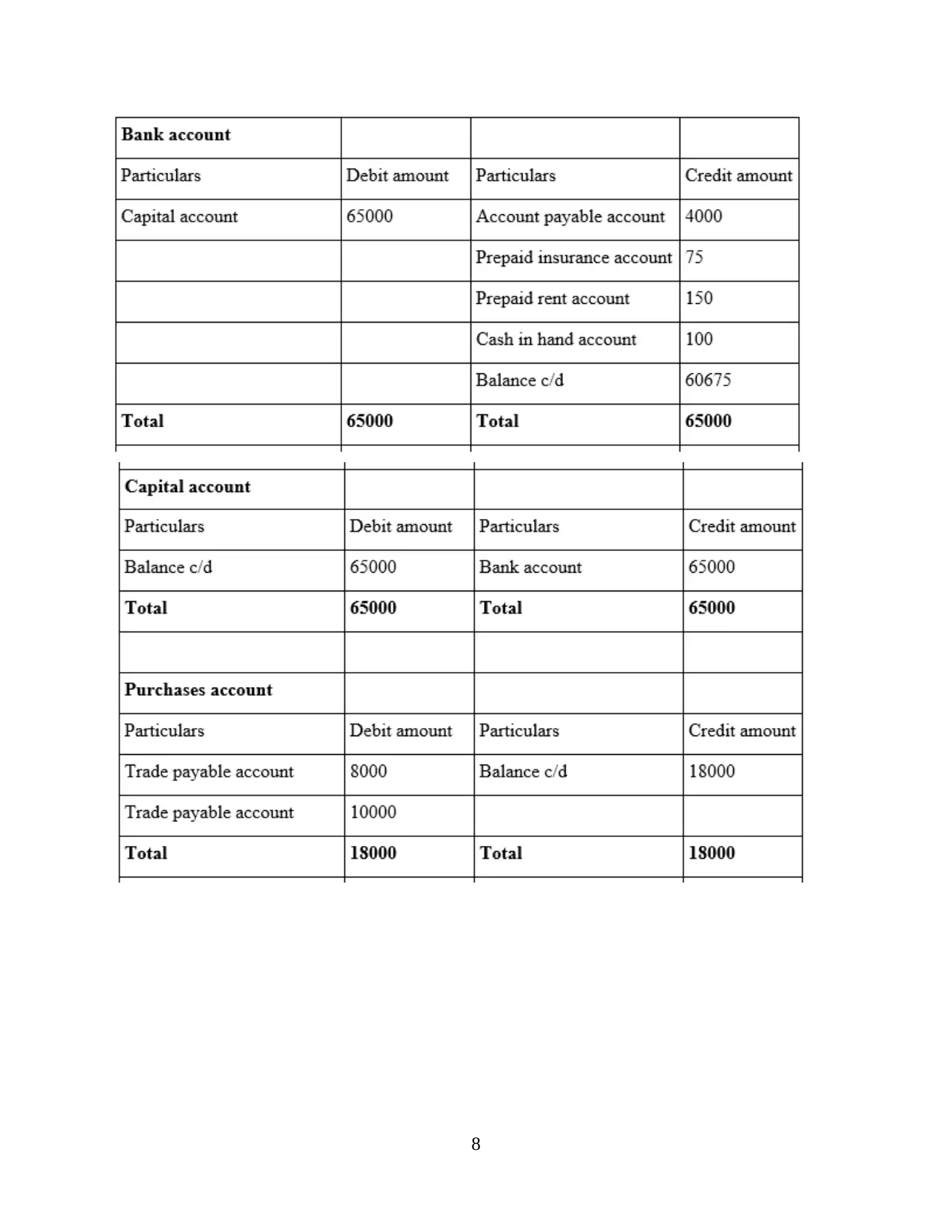
8
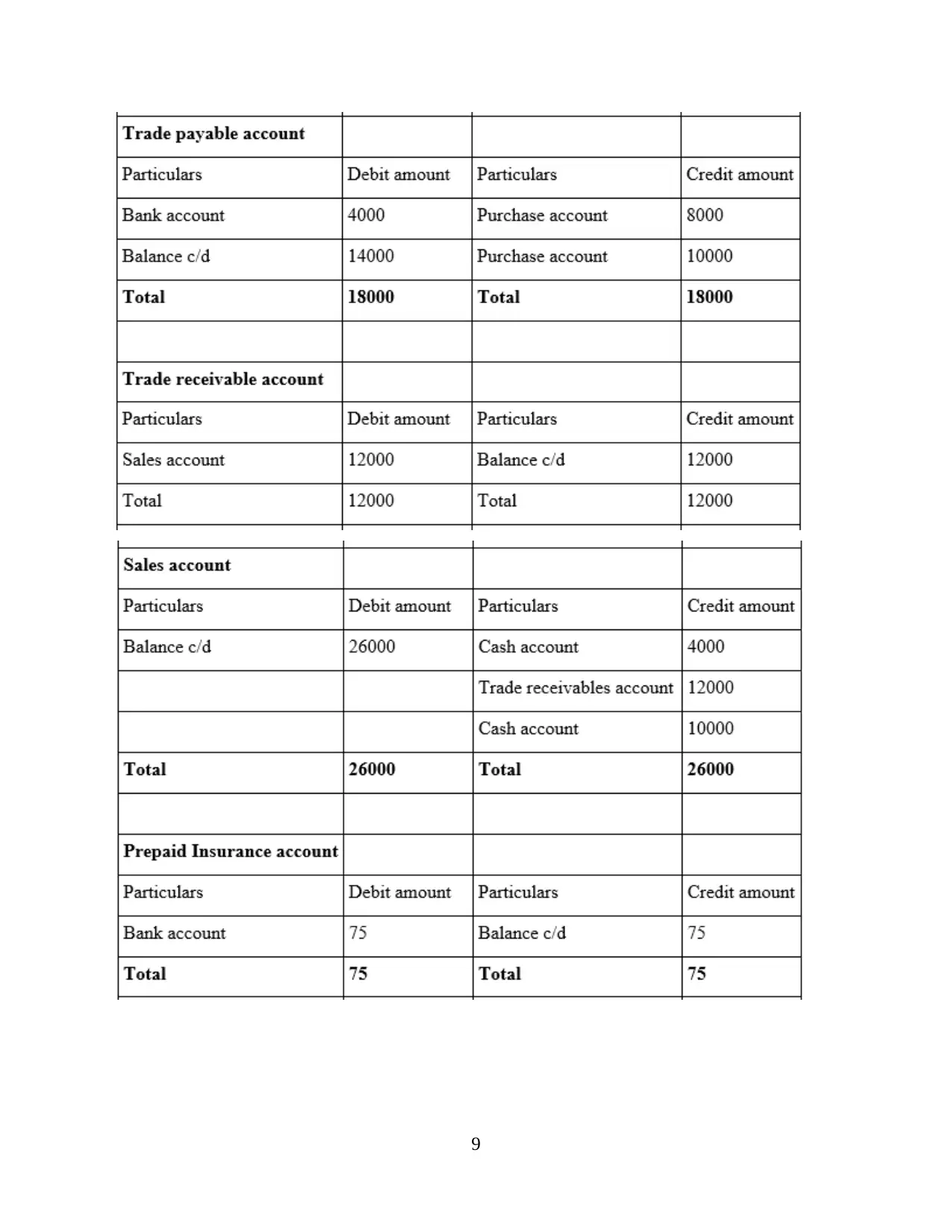
9
⊘ This is a preview!⊘
Do you want full access?
Subscribe today to unlock all pages.

Trusted by 1+ million students worldwide
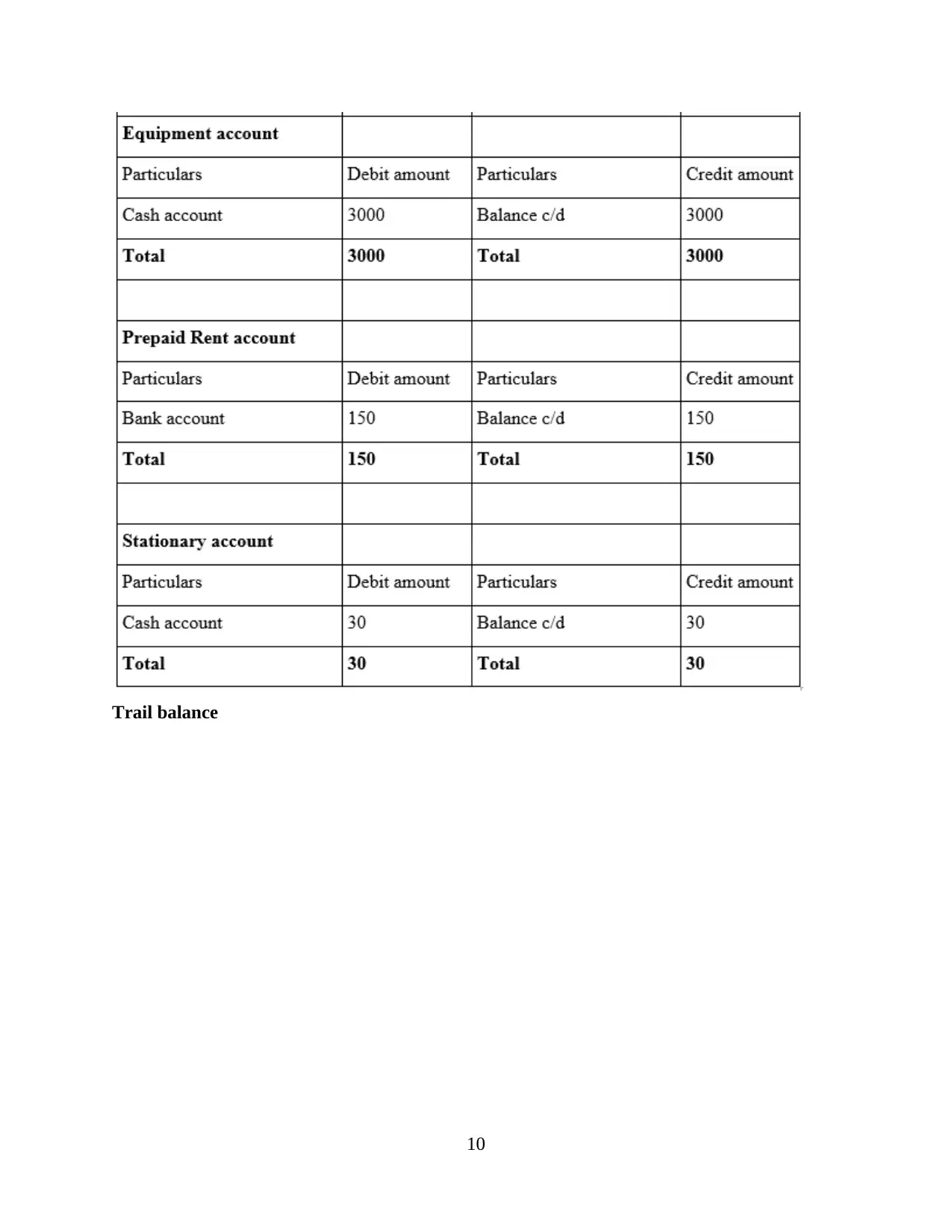
Trail balance
10
10
Paraphrase This Document
Need a fresh take? Get an instant paraphrase of this document with our AI Paraphraser
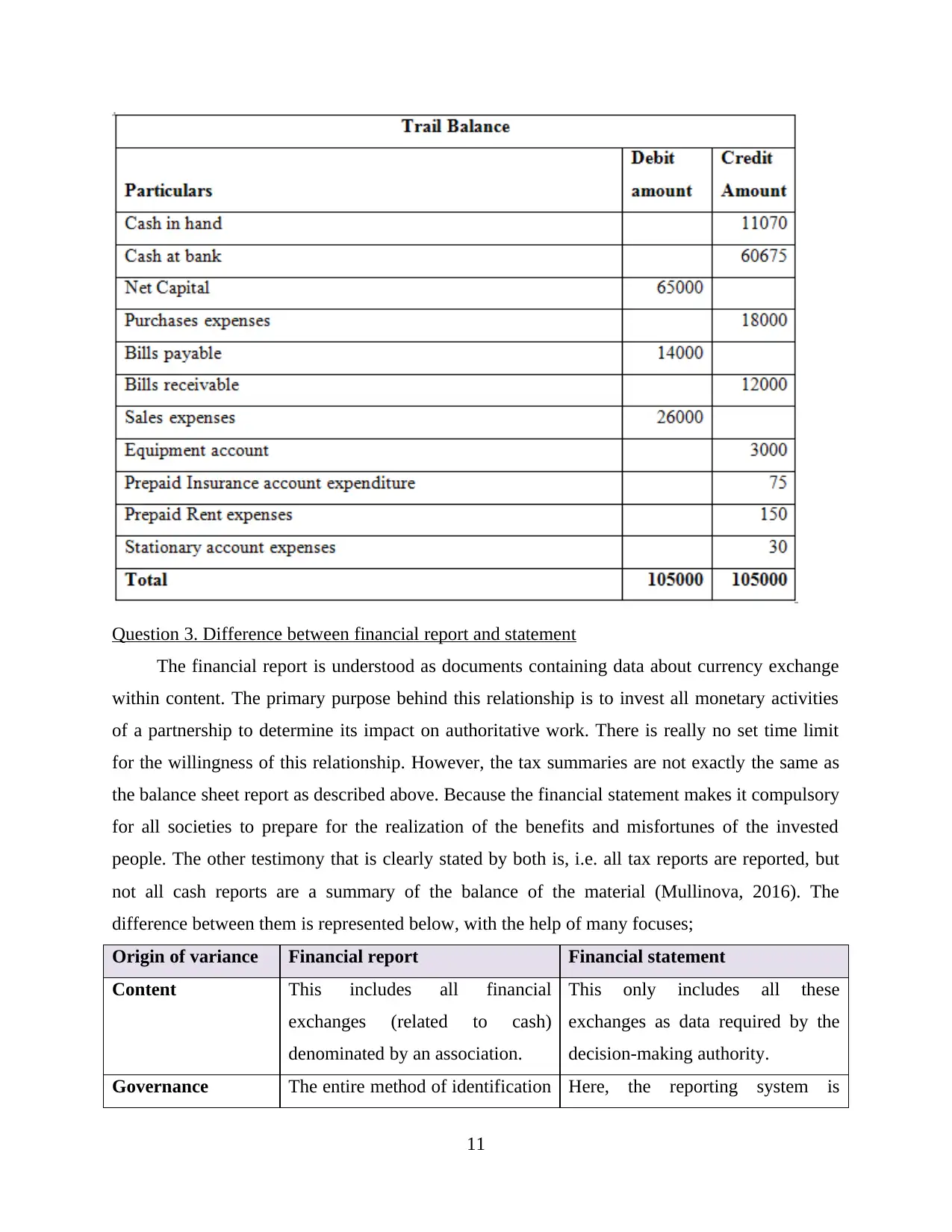
Question 3. Difference between financial report and statement
The financial report is understood as documents containing data about currency exchange
within content. The primary purpose behind this relationship is to invest all monetary activities
of a partnership to determine its impact on authoritative work. There is really no set time limit
for the willingness of this relationship. However, the tax summaries are not exactly the same as
the balance sheet report as described above. Because the financial statement makes it compulsory
for all societies to prepare for the realization of the benefits and misfortunes of the invested
people. The other testimony that is clearly stated by both is, i.e. all tax reports are reported, but
not all cash reports are a summary of the balance of the material (Mullinova, 2016). The
difference between them is represented below, with the help of many focuses;
Origin of variance Financial report Financial statement
Content This includes all financial
exchanges (related to cash)
denominated by an association.
This only includes all these
exchanges as data required by the
decision-making authority.
Governance The entire method of identification Here, the reporting system is
11
The financial report is understood as documents containing data about currency exchange
within content. The primary purpose behind this relationship is to invest all monetary activities
of a partnership to determine its impact on authoritative work. There is really no set time limit
for the willingness of this relationship. However, the tax summaries are not exactly the same as
the balance sheet report as described above. Because the financial statement makes it compulsory
for all societies to prepare for the realization of the benefits and misfortunes of the invested
people. The other testimony that is clearly stated by both is, i.e. all tax reports are reported, but
not all cash reports are a summary of the balance of the material (Mullinova, 2016). The
difference between them is represented below, with the help of many focuses;
Origin of variance Financial report Financial statement
Content This includes all financial
exchanges (related to cash)
denominated by an association.
This only includes all these
exchanges as data required by the
decision-making authority.
Governance The entire method of identification Here, the reporting system is
11
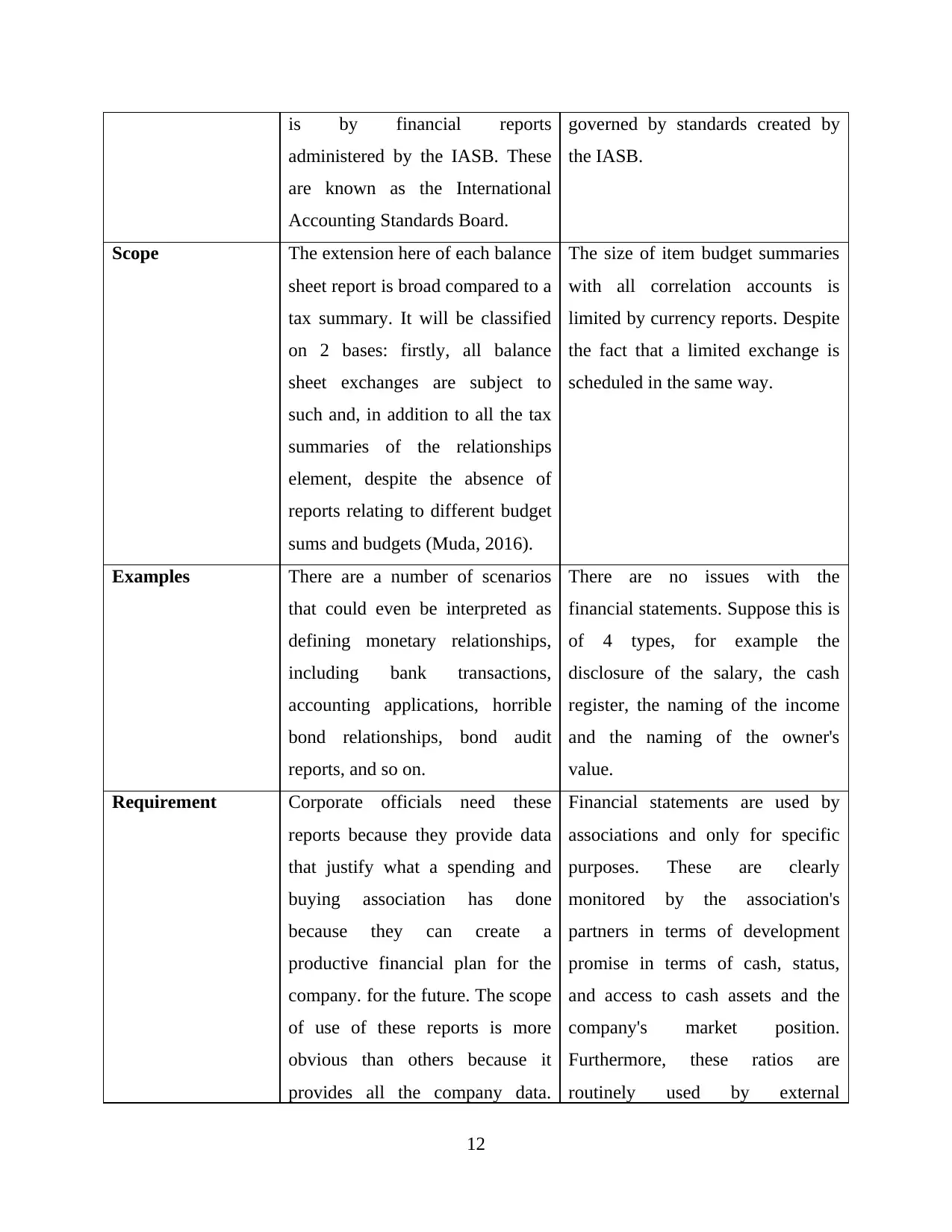
is by financial reports
administered by the IASB. These
are known as the International
Accounting Standards Board.
governed by standards created by
the IASB.
Scope The extension here of each balance
sheet report is broad compared to a
tax summary. It will be classified
on 2 bases: firstly, all balance
sheet exchanges are subject to
such and, in addition to all the tax
summaries of the relationships
element, despite the absence of
reports relating to different budget
sums and budgets (Muda, 2016).
The size of item budget summaries
with all correlation accounts is
limited by currency reports. Despite
the fact that a limited exchange is
scheduled in the same way.
Examples There are a number of scenarios
that could even be interpreted as
defining monetary relationships,
including bank transactions,
accounting applications, horrible
bond relationships, bond audit
reports, and so on.
There are no issues with the
financial statements. Suppose this is
of 4 types, for example the
disclosure of the salary, the cash
register, the naming of the income
and the naming of the owner's
value.
Requirement Corporate officials need these
reports because they provide data
that justify what a spending and
buying association has done
because they can create a
productive financial plan for the
company. for the future. The scope
of use of these reports is more
obvious than others because it
provides all the company data.
Financial statements are used by
associations and only for specific
purposes. These are clearly
monitored by the association's
partners in terms of development
promise in terms of cash, status,
and access to cash assets and the
company's market position.
Furthermore, these ratios are
routinely used by external
12
administered by the IASB. These
are known as the International
Accounting Standards Board.
governed by standards created by
the IASB.
Scope The extension here of each balance
sheet report is broad compared to a
tax summary. It will be classified
on 2 bases: firstly, all balance
sheet exchanges are subject to
such and, in addition to all the tax
summaries of the relationships
element, despite the absence of
reports relating to different budget
sums and budgets (Muda, 2016).
The size of item budget summaries
with all correlation accounts is
limited by currency reports. Despite
the fact that a limited exchange is
scheduled in the same way.
Examples There are a number of scenarios
that could even be interpreted as
defining monetary relationships,
including bank transactions,
accounting applications, horrible
bond relationships, bond audit
reports, and so on.
There are no issues with the
financial statements. Suppose this is
of 4 types, for example the
disclosure of the salary, the cash
register, the naming of the income
and the naming of the owner's
value.
Requirement Corporate officials need these
reports because they provide data
that justify what a spending and
buying association has done
because they can create a
productive financial plan for the
company. for the future. The scope
of use of these reports is more
obvious than others because it
provides all the company data.
Financial statements are used by
associations and only for specific
purposes. These are clearly
monitored by the association's
partners in terms of development
promise in terms of cash, status,
and access to cash assets and the
company's market position.
Furthermore, these ratios are
routinely used by external
12
⊘ This is a preview!⊘
Do you want full access?
Subscribe today to unlock all pages.

Trusted by 1+ million students worldwide
1 out of 22
Related Documents
Your All-in-One AI-Powered Toolkit for Academic Success.
+13062052269
info@desklib.com
Available 24*7 on WhatsApp / Email
![[object Object]](/_next/static/media/star-bottom.7253800d.svg)
Unlock your academic potential
Copyright © 2020–2025 A2Z Services. All Rights Reserved. Developed and managed by ZUCOL.





